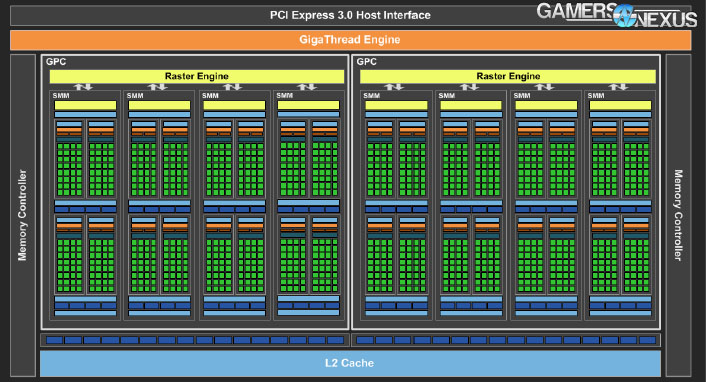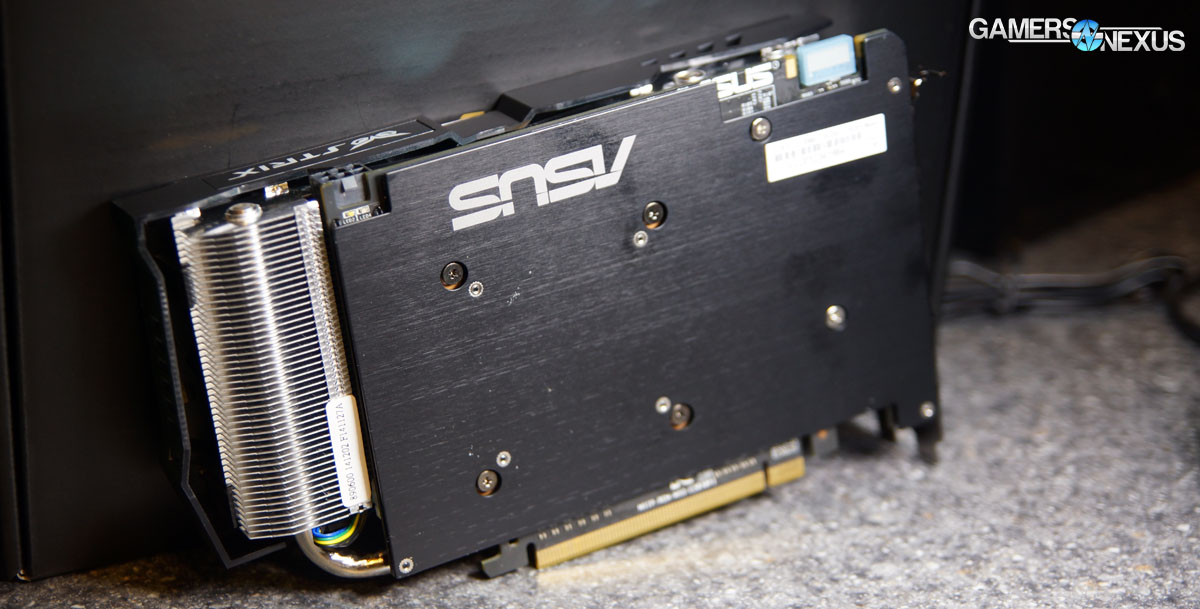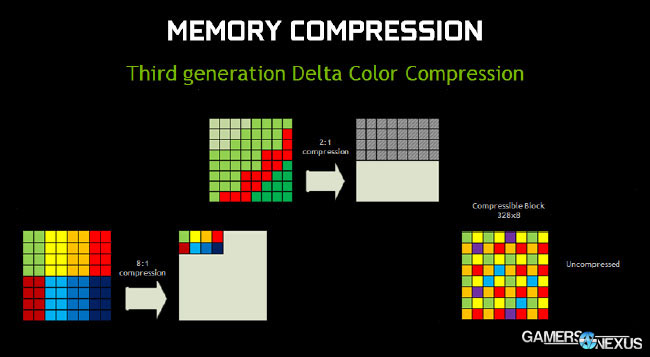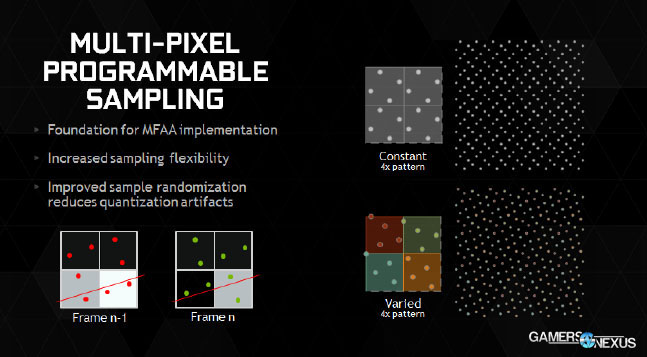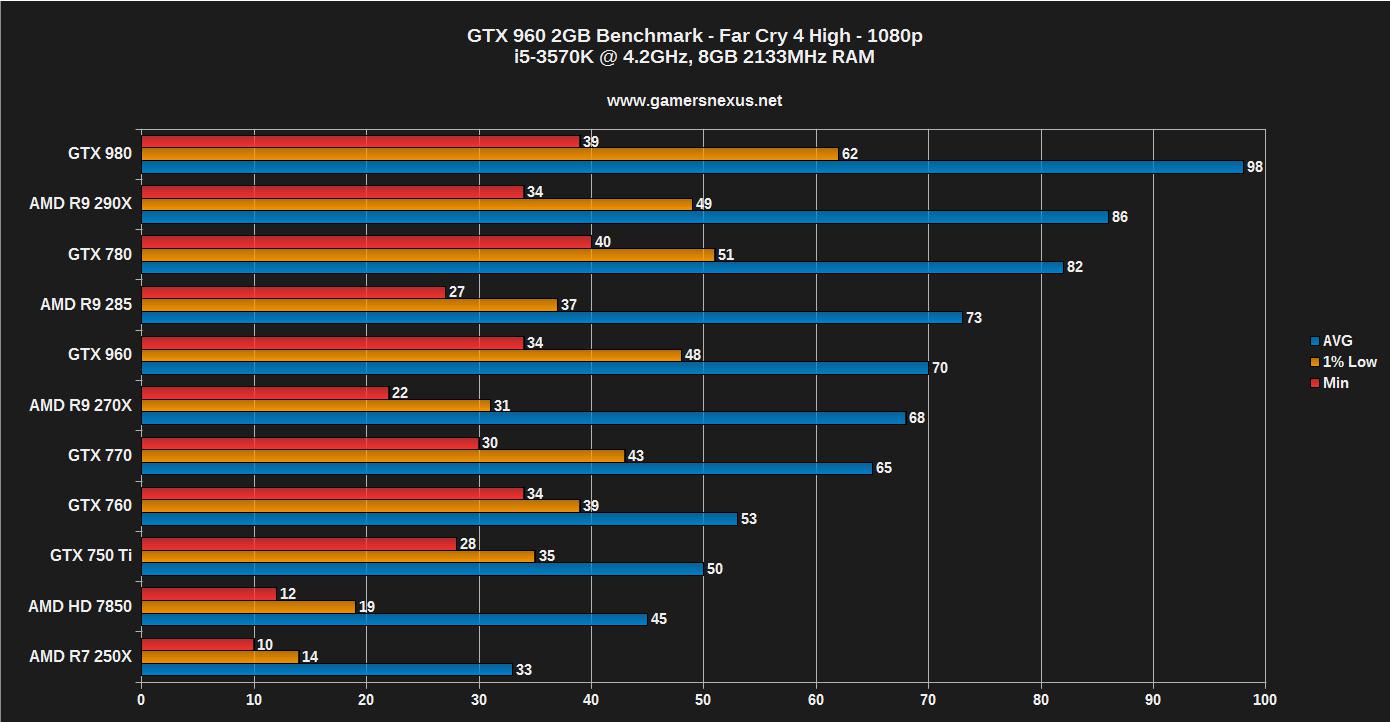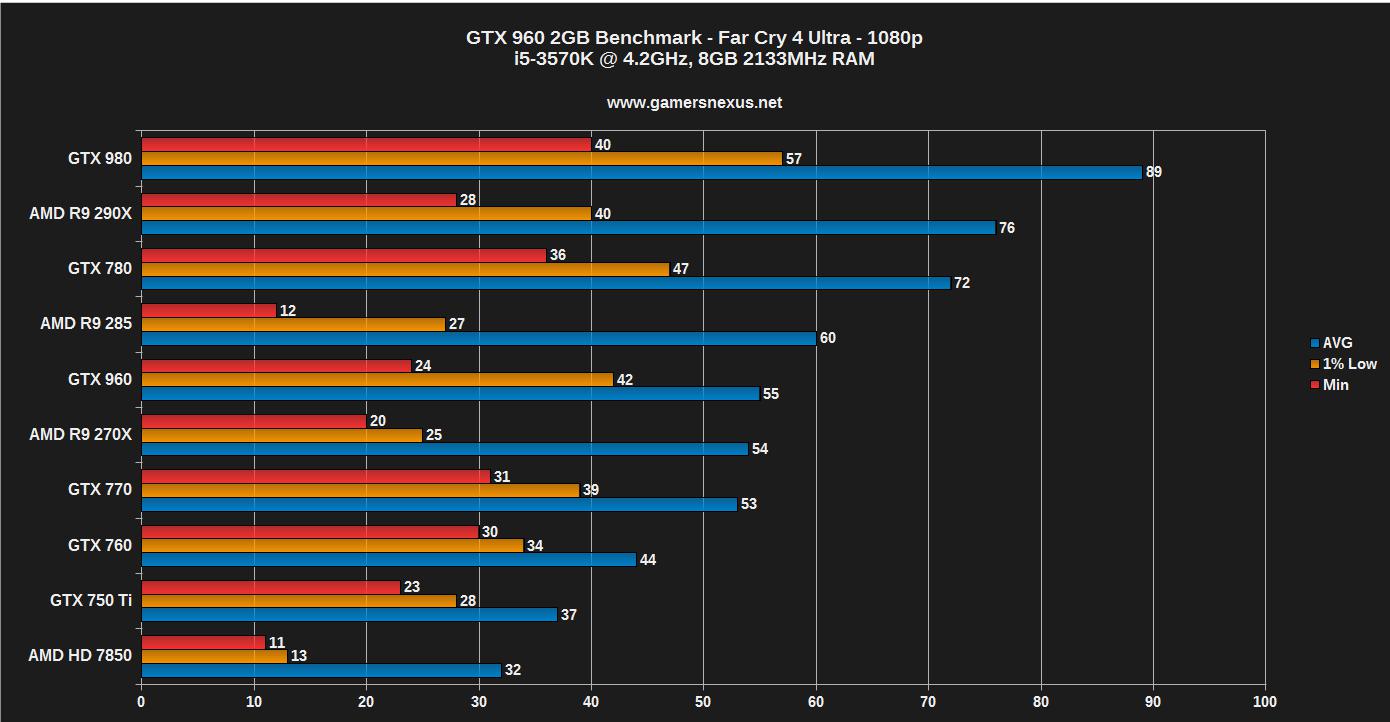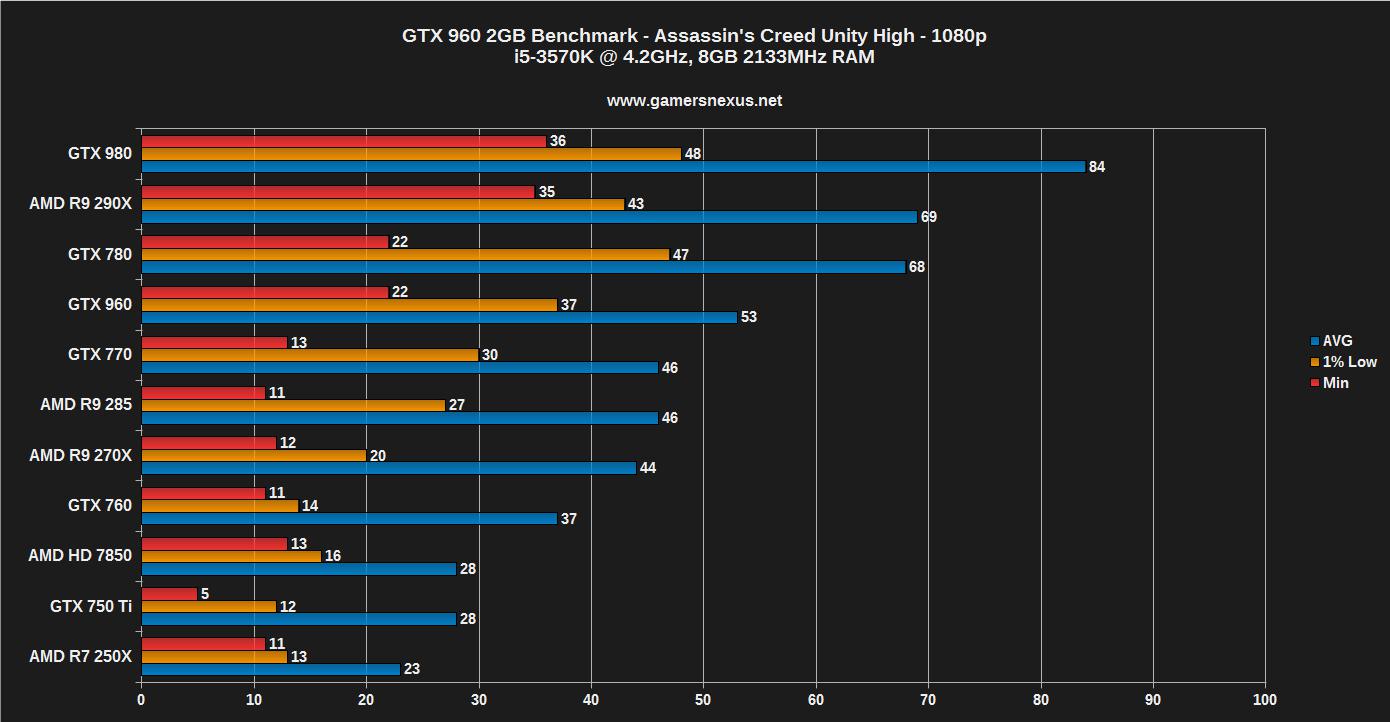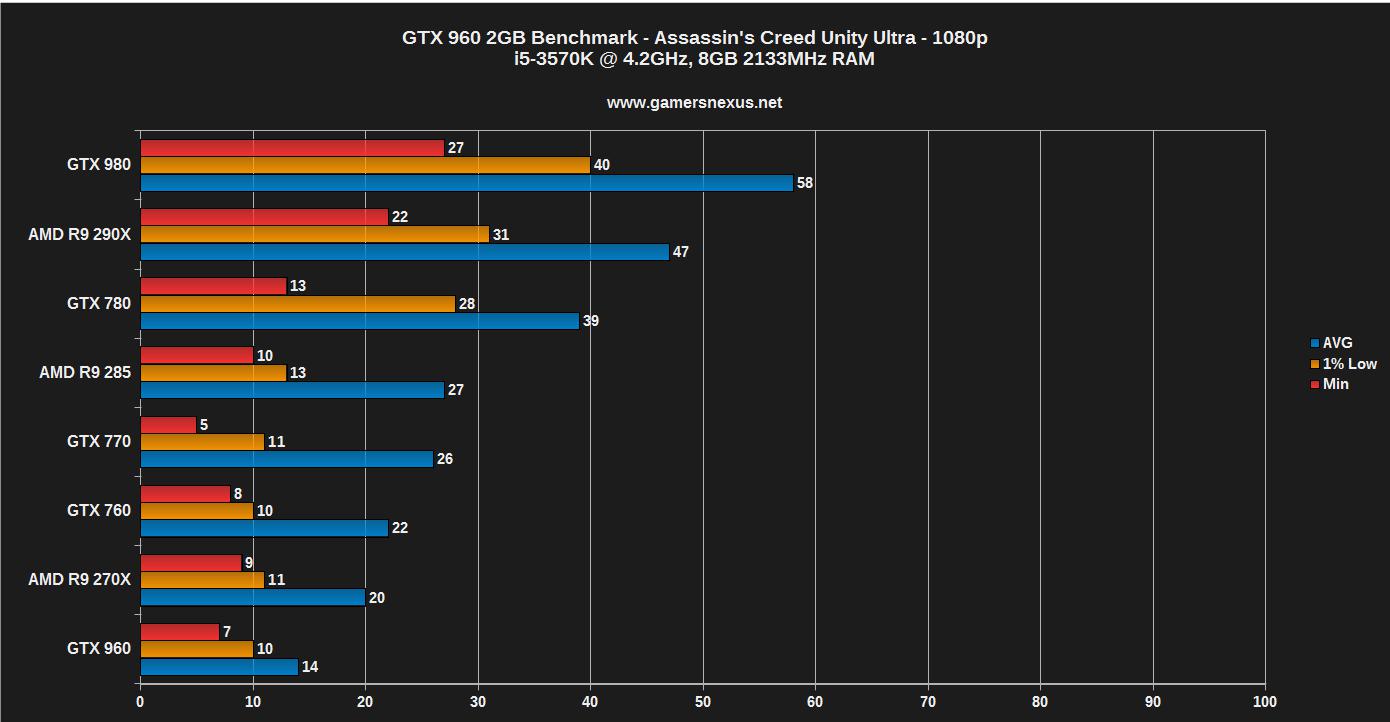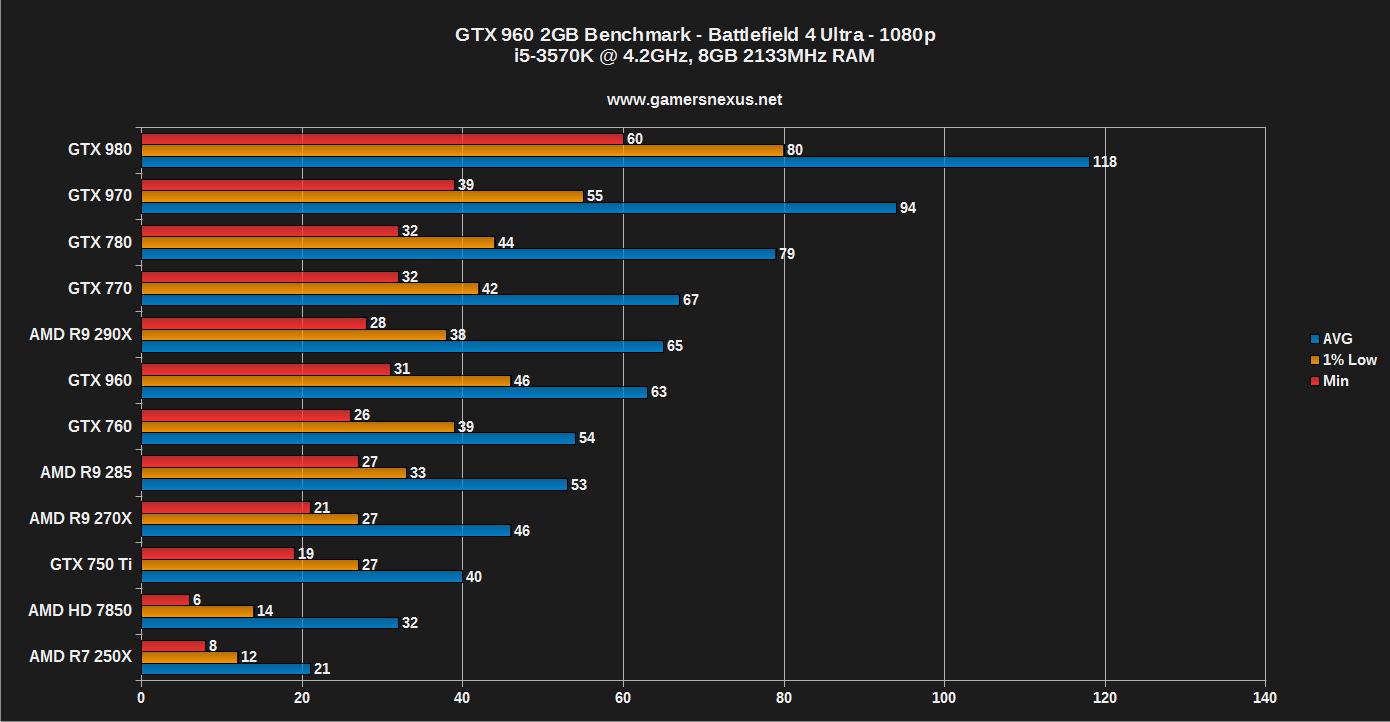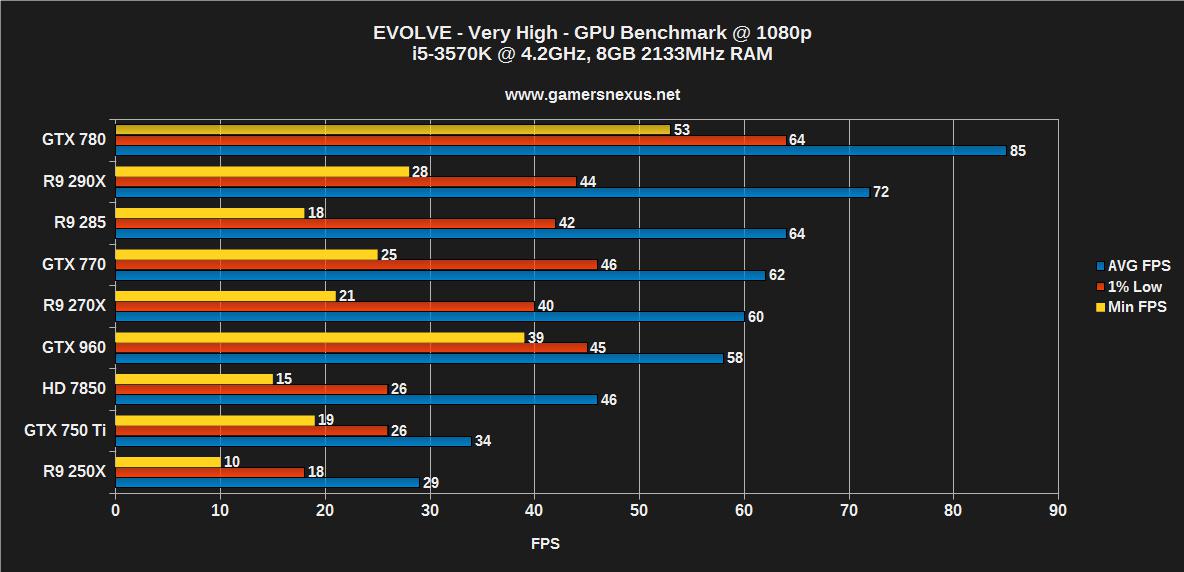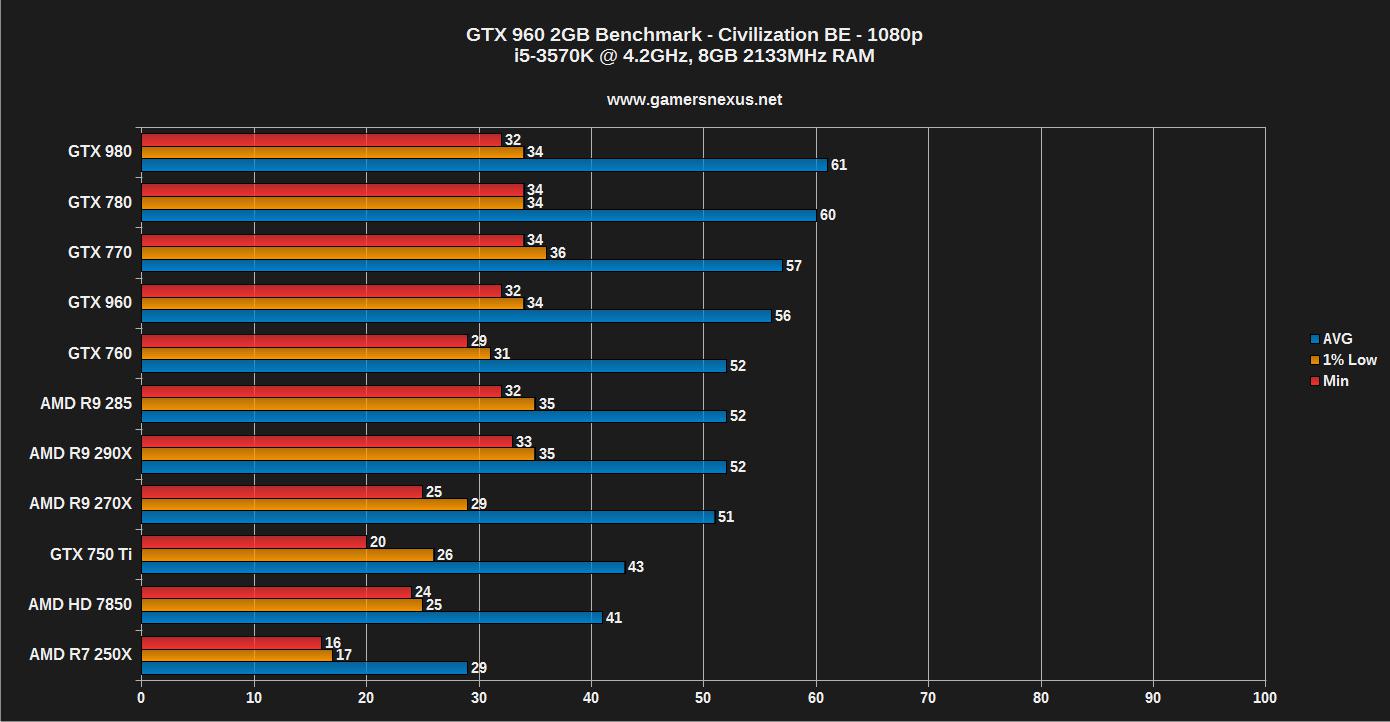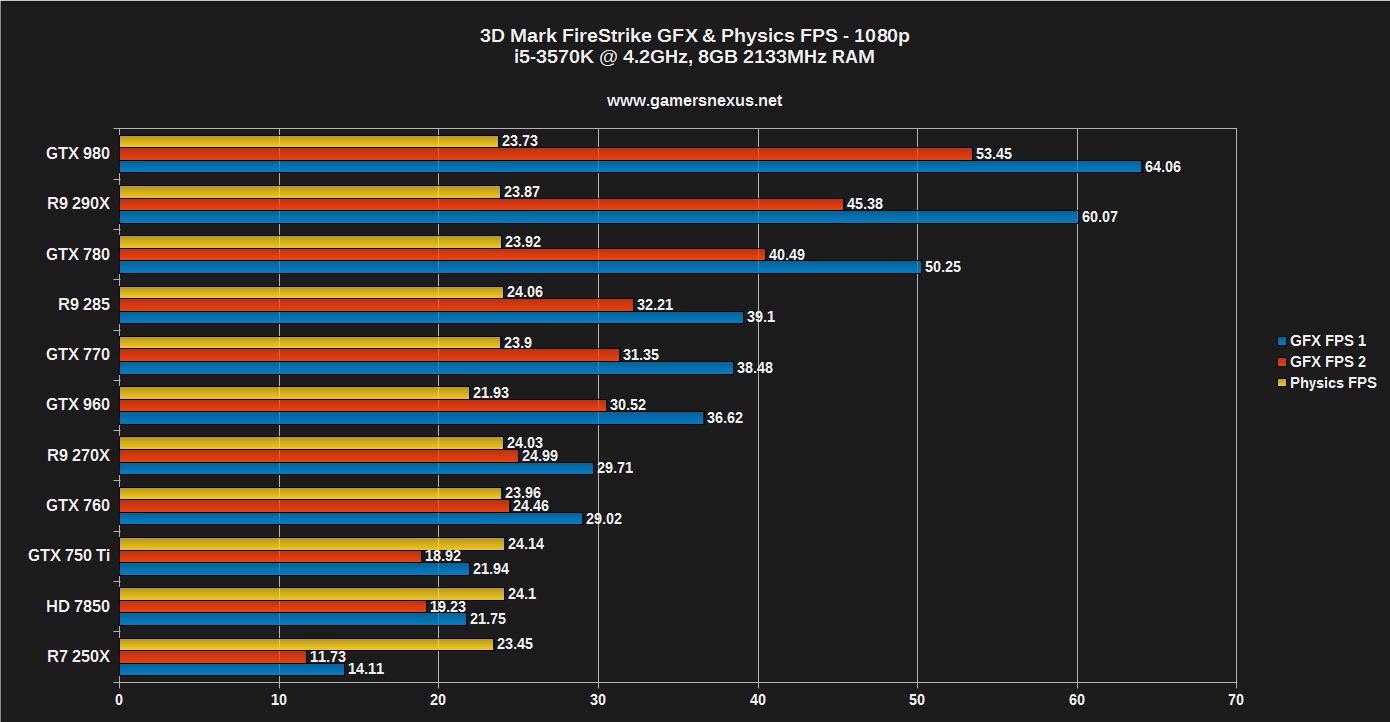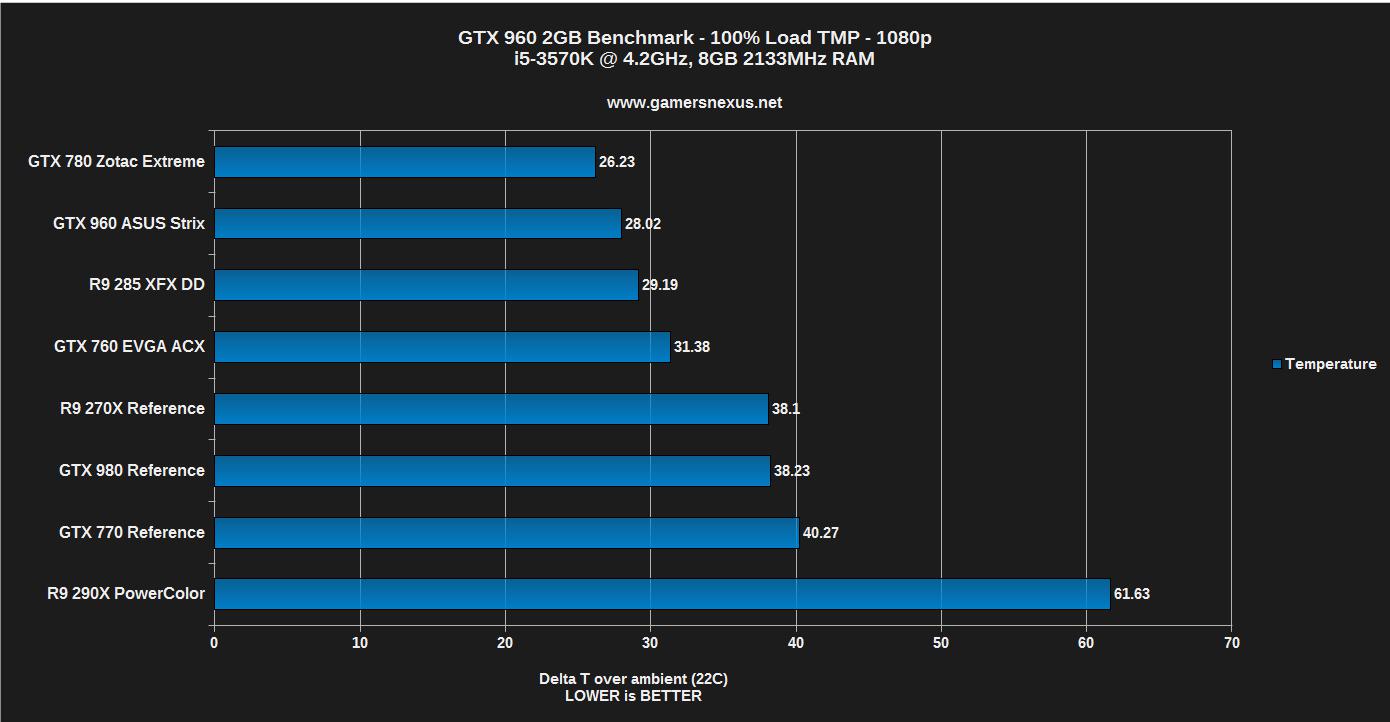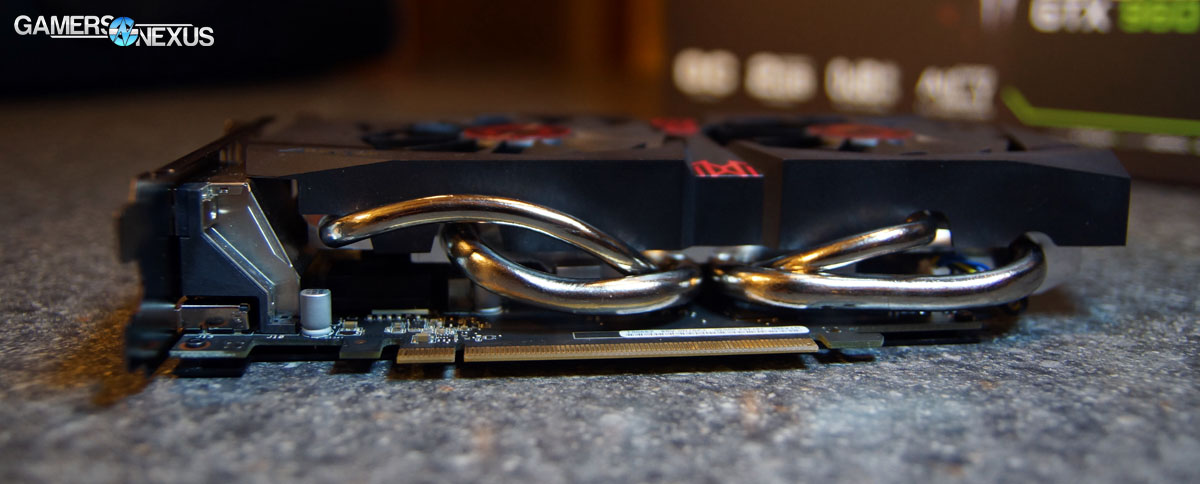NVIDIA GeForce GTX 960 GPU Benchmark vs. 760, 970, R9 285 – A $200 Juggernaut
Posted on
It's official: The price gap between the GTX 960 and GTX 970 is large enough to drive a Ti through. NVidia's new GeForce GTX 960 2GB graphics card ships at $200, pricing it a full $50 cheaper than the GTX 760's launch price. The immediate competition would be AMD's R9 285, priced almost equivalently.
NVidia's GTX 960 is intended to target the market seeking the best video card for the money – a segment that both AMD and nVidia call the “sweet spot” – and is advertised as capable of playing most modern games on high settings or better. The GTX 960 uses a new Maxwell GPU, called the GM206, for which the groundwork was laid by the GTX 980's GM204 GPU. In our GTX 980 review, we mentioned that per-core performance and per-watt performance had increased substantially, resulting in a specs listing that exhibits a lower core count and smaller memory interface. AMD has leveraged these number changes in recent marketing outreaches, something we'll discuss in the conclusion.
This GeForce GTX 960 review tests the new ASUS Strix 960 video card against the 970, 760, R9 285, & others. The benchmark analyzes GTX 960 FPS performance in titles like Far Cry, Assassin's Creed, EVOLVE, and other modern titles. The GTX 960 is firmly designed for 1080p gaming, which is where the vast majority of monitors currently reside.
ASUS GTX 960 Strix Review – FPS, Temperatures, & More
NVIDIA GeForce GTX 960, 970, & 980 Video Card Specs
| GTX 980 | GTX 970 | GTX 960 | |
| GPU | GM204 | GM204 | GM206 |
| Fab Process | 28nm | 28nm | 28nm |
| Texture Filter Rate (Bilinear) | 144.1GT/s | 109.2GT/s | 72.1GT/s |
| TjMax | 95C | 95C | 95C |
| Transistor Count | 5.2B | 5.2B | 2.94B |
| ROPs | 64 | 64 | 32 |
| TMUs | 128 | 104 | 64 |
| CUDA Cores | 2048 | 1664 | 1024 |
| Base Clock (GPU) | 1126MHz | 1050MHz | 1126MHz |
| Boost CLK | 1216MHz | 1178MHz | 1178MHz |
| Single Precision | 5TFLOPs | 4TFLOPs | 2.3TFLOPs |
| Mem Config | 4GB / 256-bit | 4GB / 256-bit | 2GB / 128-bit |
| Mem Bandwidth | 224GB/s | 224GB/s | 112.16GB/s |
| Mem Speed | 7Gbps (9Gbps effective - read below) | 7Gbps (9Gbps effective) | 7Gbps (9Gbps effective) |
| Power | 2x6-pin | 2x6-pin | 1x6-pin |
| TDP | 165W | 145W | 120W |
| Output | DL-DVI HDMI 2.0 3xDisplayPort 1.2 | DL-DVI HDMI 2.0 3xDisplayPort 1.2 | 3xDisplayPort 1.2 1xHDMI 1xDL-DVI |
| MSRP | $550 | $330 | $200 |
As with both preceding Maxwell processors, the count-for-count specifications of the GTX 960 are deceptively low. The GTX 960 hosts a single GM206 GPU, equipped with 8 Streaming Multiprocessors to net a total of 1024 CUDA Cores. It's important to note that cross-architecture comparisons of core count aren't linear, as the Maxwell CUDA cores are roughly 1.4x more powerful than Kepler cores. We'll get into this momentarily.
Looking at the rest of the specs, the GTX 960 ships strictly in a 2GB model using a 128-bit bus, which makes use of heavy color compression to reduce saturation of the memory bandwidth (which is 112.16GB/s). The effective speed of the memory is 9300MHz due to these efficiency gains, operating a memory clock of 7010MHz natively.
Continuing the joint trend by all semiconductor manufacturers, the GTX 960 has dropped its TDP to just 120W, a marked decrease over the GTX 760's 170W power requirement. As a result of the low TDP, the GTX 960 can be powered by a single 6-pin PCI-e connector and the PCI-e slot alone. Notably, some board partners will be manufacturing overclocking-targeted GTX 960s with additional power headers for increased OC overhead.
NVidia still rests on 28nm fabrication process and likely will not change that for the remainder of this GeForce generation.
A Quick Refresher on Maxwell - CUDA Core Performance 1.4x Over Kepler
We'd recommend reading our GTX 980 review & architecture drill-down for full information on all major gaming-relevant Maxwell features.
The GM206 hosts almost all of the same architectural features introduced in the GM204 GTX 980 GPU, to include delta color correction and per-core efficiency gains, but makes a few key changes.
As with all Maxwell GPUs, the SMM is broken into four blocks. Each block possesses 32 CUDA cores, making for a total of 128 cores per streaming multiprocessor (there are eight in the 960). Each SMM hosts 96KB of shared memory, then combines the L1 texture caching functionality into a 24KB memory pool (one pool shared between two CUDA blocks, or 64 cores). For comparison, Kepler's GPUs hosted a 64KB pool that was also shared with L1 cache.
Among other changes that will be discussed shortly, these key modifications to Maxwell over Kepler contributed to a 40% performance-per-core increase, ultimately netting a 2x performance-per-watt gain.
I said there were new features in GM206 that were not found in GM204, though. The most noteworthy addition to GM206 and the GTX 960 is a new video engine, now capable of full H.265 HEVC (encoding & decoding), whereas the GTX 980 could only encode. We previously wrote that H.265 had finally been approved by the ITU. H.265 encoding (all our videos are encoded in H.264) will substantially decrease bandwidth requirements, allowing content creators to pack more data into a smaller file, allowing for less abusive data streams. This becomes critical as the world moves toward higher resolution output, which further increases demand for high bit-rate media (the bit-rate must increase in step with resolution to prevent a drop in overall quality).
The GTX 960's H.265 decoding support means better support for high-quality media going forward, although we think this is still somewhat far off; 4K & 5K are still buzzwords at this point, and media produced for the standards is rare. Buying a GPU strictly on the expectation that media (and then H.265-encoded media, still effectively non-existent) will soon be produced en masse seems a bit of a stretch, though it has plenty of other merits.
Aside from this change, it's important to note that the GM206 uses the same memory subsystem to what the GM204 and GTX 980 featured. As discussed in page two of our 980 review, third-generation delta color compression (example below) looks at individual object color delta temporally (from one frame to the next, or over time). Once analyzed, the delta (difference between the previous color and the new one) is calculated, rather than performing absolute calculations for every color on the screen; this also prevents colors that remained the same from being reacquired. Overall, this memory subsystem results in roughly 25% fewer bytes per frame vs. Kepler. The key note here is that a 128-bit memory interface – when looked at in real-world gaming applications – is capable of outperforming the GK106's 192-bit memory interface.
MFAA Finally Gets Introduced
Although it was written about in our GTX 980 review and at Game24, nVidia's more bandwidth-efficient MFAA (multi-frame sampled anti-aliasing) hasn't actually made it into many games. The launch of the GTX 960 comes shortly after expanded MFAA support by games, to include Dragon Age: Inquisition, ARMA III, Far Cry 4, and others. In testing, MFAA improves performance on mid-range hardware (like the GTX 960) somewhat substantially without producing a noticeable quality decrease.
MFAA operates temporally, taking pixel samples from the previous frame and the impending frame, then combining them to determine the best pixel color (improving smoothness, as all anti-aliasing technologies do). This means the workload is split over a period of two frames, rather than loading the GPU heavily on a single frame basis.
Let's get to the GTX 960 benchmarks. Continue on to Page 2 for the charts.
The Card We're Reviewing: ASUS' GTX 960 Strix Specs vs. Reference
ASUS' new GTX 960 Strix card will appear here on launch day, though we're not sure of the precise time. We're told that the quieter Strix 960 will retail for $210, meanwhile EVGA & Zotac will both offer day-one overclocking solutions for $200.
| GTX 960 | GTX 960 Strix | |
| Base Clock (GPU) | 1126MHz | 1291MHz |
| Boost CLK | 1178MHz | 1317MHz |
| Mem Config | 2GB / 128-bit | 2GB / 128-bit |
| Mem Speed | 7010MHz | 7200MHz |
| Power | 1x6-pin | 1x6-pin |
| TDP | 120W | 120W |
| MSRP | $200 | ASUS GTX 960 Strix $210 |
Because the GTX 960 can run at 30W when playing some games – DOTA 2 & LoL included – some manufacturers' cards will automatically power-down fans until a more demanding task is at hand. This reduces overall noise (to 0dB from the GPU) and power draw, but doesn't threaten the integrity of the GPU given the light workload.
Test Methodology
The GTX 960 was tested using the latest NVIDIA GeForce drivers (347.25); all AMD devices were tested with the latest Catalyst Omega driver download. Tests were conducted using various games (listed below) and the synthetic 3D Mark benchmarking suite. FPS logging was performed with FRAPS and then analyzed with FRAFS; thermal and sensor monitoring was performed with GPU-Z.
All game and synthetic benchmarks were performed three times for parity, then averaged.
Game setting presets used during testing are identified by the title of the chart. Some settings are manually tweaked to allow for a more fair comparison between GPU vendors.
Unfortunately, despite requesting one, a Radeon R9 280 was not available for this benchmark.
In FPS and game benchmark performance testing, we used the following titles:
- Metro: Last Light Benchmark.
- GRID: Autosport Benchmark.
- Battlefield 4 Gameplay.
- Assassin's Creed Unity (PC).
- Far Cry 4 (PC).
- Sid Meier's Civilization: Beyond Earth.
- 3D Mark.
| GN Test Bench 2013 | Name | Courtesy Of | Cost |
| Video Card | (This is what we're testing). | NVIDIA. | $200 |
| CPU | Intel i5-3570k CPU Intel i7-4770K CPU (alternative bench). | GamersNexus CyberPower | ~$220 |
| Memory | 16GB Kingston HyperX Genesis 10th Anniv. @ 2400MHz | Kingston Tech. | ~$117 |
| Motherboard | MSI Z77A-GD65 OC Board | GamersNexus | ~$160 |
| Power Supply | NZXT HALE90 V2 | NZXT | Pending |
| SSD | Kingston 240GB HyperX 3K SSD | Kingston Tech. | ~$205 |
| Optical Drive | ASUS Optical Drive | GamersNexus | ~$20 |
| Case | Phantom 820 | NZXT | ~$130 |
| CPU Cooler | Thermaltake Frio Advanced | Thermaltake | ~$65 |
The system was kept in a constant thermal environment (21C - 22C at all times) while under test. 2x4GB memory modules were kept overclocked at 2133MHz. All case fans were set to 100% speed and automated fan control settings were disabled for purposes of test consistency and thermal stability.
A 120Hz display was connected for purposes of ensuring frame throttles were a non-issue. The native resolution of the display is 1920x1080. V-Sync was completely disabled for this test.
The video cards tested include:
- AMD Radeon R9 290X 4GB (provided by CyberPower).
- AMD Radeon R9 285 (provided by AMD/XFX).
- AMD Radeon R9 270X 2GB (we're using reference; provided by AMD).
- AMD Radeon HD 7850 1GB (bought by GamersNexus).
- AMD Radeon R7 250X 1GB (equivalent to HD 7770; provided by AMD).
- NVidia GeForce GTX 980 (provided by nVidia).
- NVidia GeForce GTX 970 (provided by ZOTAC).
- NVidia GeForce GTX 960 (provided by ASUS/nVidia).
- NVidia GTX 780 Ti 3GB (provided by nVidia).
- NVidia GTX 780 3GB x 2 (provided by ZOTAC).
- NVidia GTX 770 2GB (we're using reference; provided by nVidia).
- NVidia GTX 750 Ti Superclocked 2GB (provided by nVidia).
Metro: Last Light FPS Benchmark – GTX 960 vs. 760, 970, R9 285, 270X, & More
Metro: Last Light is one of the most consistent benchmarking utilities we've ever encountered. The ASUS GTX 960 Strix landed just below AMD's same-priced R9 285 ($210), which holds a 5.6% lead over the lower-TDP nVidia GPU. Performance was smooth and uninhibited by stuttering or noticeable frame tearing.
The GTX 960 sees roughly a 38% improvement over the previous-generation GTX 760 (now discontinued). The GeForce GTX 970 outperforms the GeForce GTX 960 by about 34% in this test.
Far Cry 4 Benchmark – GTX 960 vs. 760, 770, 980, 290X, 285
First, note that Far Cry 4 (PC) has improved substantially since our initial benchmark, which unrooted severe stuttering issues on some devices.
The GTX 960 is capable of playing Far Cry 4 on near-max (Ultra) settings with some tweaks, resulting in a 55FPS average output on ultra. The card sits around 70FPS on “high” settings, ensuring a more stable gameplay experience with fewer visible dips.
Compared against the GTX 760, the GTX 960 welcomes a ~28% gain in framerate with high settings on Far Cry 4. Although not on this chart due to availability, the GTX 970 performs almost identically to the GTX 780, so you can expect a rough ~16% FPS gain by opting for a GTX 970 over a 960.
Looking at AMD, the $210 XFX Radeon R9 285 video card holds a 4.1% lead over the GTX 960.
Assassin's Creed Unity Benchmark – GTX 960 vs. 760, 770, 285, 270X
Assassin's Creed Unity nets a lead for the GTX 960 over its competing R9 285, with the GM206-powered card operating at 14.14% more frames per second. ACU was unplayable on Ultra settings, largely for VRAM reasons disclosed in our ACU benchmark.
Despite memory efficiency gains, nVidia's fault can be seen in the ACU tests; a GTX 760 outperforms the new 960 due to its wider memory bus and increased bandwidth. This is a real-world example of where a memory bus gets hammered -- especially given ACU's heavy use of VRAM (frequently exceeds 2GB if available).
GRID: Autosport FPS Benchmark – GTX 960 vs. 760, 980, 285, 290X, & More
AMD's R9 285 leads the GTX 960 by roughly 2% (within margin of error) in GRID: Autosport, with the GTX 770 leading the GTX 960 by ~10%. The GTX 960 outperforms the previous-gen GTX 760 by 14%.
Battlefield 4 Benchmark – GTX 960 vs. 760, 970, 270X, 285, 290X
Running Battlefield 4 at max settings (1080p) was somewhat easy for the GTX 960, which produced a 63 average FPS (15.4% faster than the R9 285 & GTX 760).
EVOLVE Benchmark – GTX 960 vs. R9 270X, 7850, 770
We recently benchmarked the EVOLVE beta, throwing in the GTX 960 for good measure. Note that Evolve is not a complete title and has not received driver (or much software) optimization. This test is strictly representative of beta performance.
Civilization: Beyond Earth Benchmark – GTX 960 vs. 760, 770, 750 Ti, 285, 270X
We'll be eliminating Civilization: BE from the test bed going forward, given the generally flat results. The differences showcased are insubstantial and generally not worth taking into consideration. Still, it's worth noting that the GTX 960 bested AMD in one of its optimized titles.
3D Mark Benchmark Scores – ASUS GTX 960 Strix, GTX 760, 770, 270X, 285, & More
3D Mark scores are somewhat useless if you don't understand what goes into them. Below is a chart showing the calculated score (an amalgamation of FPS results across various graphics and physics benchmarks), followed by a chart showing individual framerates for different test segments.
Note that AMD's devices tend to excel in the synthetic physics arena due to greater COMPUTE power.
GTX 960 Thermal Performance
Under 100% real-world load (FireStrike Extreme), ASUS' Strix cooler on the GTX 960 results in one of the coolest temperatures on our bench, only behind a 3-fan GTX 780 from ZOTAC. These results hinge heavily upon the cooler, so reference devices will almost always be hotter than aftermarket units. You can't extrapolate all GTX 960 cards' temperature metrics from this chart – it is representative only of the Strix variant.
Conclusion: AMD's Price Argument is Weakening, but Still Viable; Editor's Choice Recipient
The R9 285 is effectively tied with the GTX 960 when rounding-up all the results. It's a slightly more capable card in terms of raw performance, but at 190W TDP against nVidia's 120W TDP, the same price, and with worse software support, it's becoming a difficult recommendation.
If AMD were reading this, they'd tell us what they always do: “The difference between the GTX 980 and the R9 290X is about $5 a year [on your energy bill].” True – the power bill isn't that big – but in a time when small form factor boxes and home-theater PCs are growing in popularity, and as gamers realize that rigs no longer need to double as space-heaters, the TDP argument becomes more relevant. It's not just energy cost – it's the endurance and thermals of the entire system. The GPU can heat up all surrounding components, and unarguably will when in a small enclosure like the RVZ02, so it's important to pay attention to wattage demands.
Still, a great many gamers still prefer performance output over a few more watts saved. In these instances, we must divert our attention to FPS and then driver / software support. In the case of FPS, the R9 285 wins-out in a few titles, but not all; it's a blow-for-blow trade, but if you're just after every single frame you can get, it's an overall safer bet for some games. In the case of software, GFE and ShadowPlay are extremely easy to use and update with greater regularity than Catalyst and Gaming Evolved (which offers GVR, a ShadowPlay competitor we benchmarked).
And that's the other thing – GPUs can often make tremendous gains with driver updates, so ultimately, these two could trade places as AMD and nVidia continue to iterate drivers.
AMD reached out to us earlier this week with a somewhat aggressive approach to marketing – something that the two goliaths aren't foreign to – stating directly that “newer isn't always better.” In the email, the company goes on to encourage consideration of the R9 280 (sadly, we were unable to secure a sample in time) when reviewing the GTX 960. AMD specifically pointed-out the 128-bit memory interface against the R9 280's (and 285's) 256-bit interface, then emphasized the importance of a wider memory interface when playing games at 4K resolutions.
This accuracy granted, an R9 280 and GTX 960 are both incapable of playing anything high-end at 4K. AMD understands this, though, and uses DOTA2, LoL, and CSGO as examples of games that would benefit from 4K resolutions on an R9 280. Each of these games is more competitive in nature and experiences the phenomenon of players running intentionally dropped settings for the best competitive ability, so perhaps they're not the best choices – but we get the idea.
Note one important item we don't demonstrate in our charts: Although the GTX 960 and R9 285 are neck-and-neck in many cases, the R9 285 will outperform the GTX 960 in higher resolution use cases, like 1440p displays. We generally wouldn't recommend either card in such a scenario, but the 285 would perform better in general than the 960 in this instance. The 960 is definitely built for 1080p gaming and would struggle outside of that territory; we would not recommend the 960 at higher than native display resolutions of 1080p.
Although the 280X wasn't on our bench, it makes for an easy choice for gamers who care less about the power argument and favor raw framerate outputs (and have a few bucks extra to spend). Low TDP only goes so far -- there's still something to be said for a device that can drive graphics at an affordable price.
At the end of the day, it's as simple as this: AMD and nVidia are both incredibly strong contenders and have a highly competitive, somewhat entertaining tit-for-tat nature about them. It has gotten to a point that the bickering from either side is more directed in press events, something that's been exaggerated as nVidia has continued to threaten AMD's long-standing budget-class dominance. Up until today, you either bought a GTX 750 Ti or an R9 270 at the low-end, a 280 or 285 for the ~$180 range, or a GTX 970 after that. There haven't been worthwhile nVidia cards in the $150 to $300 price-range, given the generational gap, and that left an entire suite of relatively high-performing AMD devices as the only viable options. AMD still has a greater spread over the $100 to $250 market, largely due to its potentially overwhelming amount of options, but that grip is being threatened by the GTX 960.
As for the new gap that has developed – the $200 to ~$330 range – well, that looks wide enough for a Ti of some sort. Presently, AMD's R9 290 can be had for just around $260 and handily outperforms the GTX 960; we don't expect that to last forever, knowing how the two battle one another.
The Bottom Line
Strictly looking at the GTX 960 and ignoring the meta game: nVidia's new venture exhibits impressively low power consumption, is compact, affordable, and highly competitive in performance. The 960 is an easy choice for higher-end HTPCs with a thermal or power draw concern, and even outperforms the GTX 770 in some games. For desktops, the GTX 960 ($200) should be strongly considered when building a new mid-range gaming PC, right alongside AMD's embattled R9 285 ($210) and 280 ($170); the power, thermal, and software argument presently favors nVidia, though AMD still loosely holds onto higher framerates in many cases. NVidia's GTX 960 shows its memory bus limits in the ACU tests, where the GTX 760 is able to edge-out nVidia's new GPU thanks to its wider memory bus and increased bandwidth. Despite the efficiency gains, a wider bus would certainly have benefitted the GTX 960. The R9 280X makes for a solid high-performer compared to the rest of the lot, though it costs a bit more at ~$220-$250.
It's ultimately the user's experience that matters most, so take special build requirements into account (are thermals or power draw relevant for your build?) and then choose accordingly.
- Steve “Lelldorianx” Burke.
